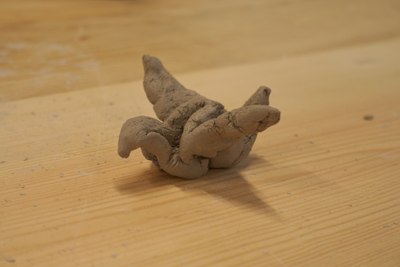Folding Unfired Clay

This summer, I visited the Fort at Srebrna Góra, a huge mountain keep from the 18th century. Besides various exhibitions about the military aspect of the fortress, there were also interesting exhibitions about the daily life as well as some workshops, including a pottery class. I used this opportunity to test yet another unusual “paper”, that is clay.
The traditional crane shown here is made from a thin sheet of clay cut into a roughly square shape and folded. There was no kiln yet at the workshop, and no time to fire the objects made in class, so this is unfired clay: still wet and soft. Nonetheless, the model kept its shape pretty well. The sheet had to be quite thick, probably at least a centimeter or so, but I was surprised that I could actually fold it, and it did not stick to itself as much as I had feared. I was able to finish the model (besides thinning the tail and neck) and while the folding is not very precise, the crane is clearly recognizable. The thickness of the sheet gives it a cute, cartoonish look.
It would be interesting to see the model after firing: maybe I get another chance to try folding clay some time. There are factory-made ceramic cranes, and I even own one, but those are made in a form while mine is an actual folded model rather than just a lookalike. I’d also like to try different models, perhaps a box or a tessellation molecule, even though this medium is not well-suited for models that require precreasing. Maybe some mixed technique such as drawing the precrease in the clay with a sharpened stick would work. I think tessellation molecules folded in clay and fired would make very cool pieces, resembling decorated ceramic tiles.
Comments